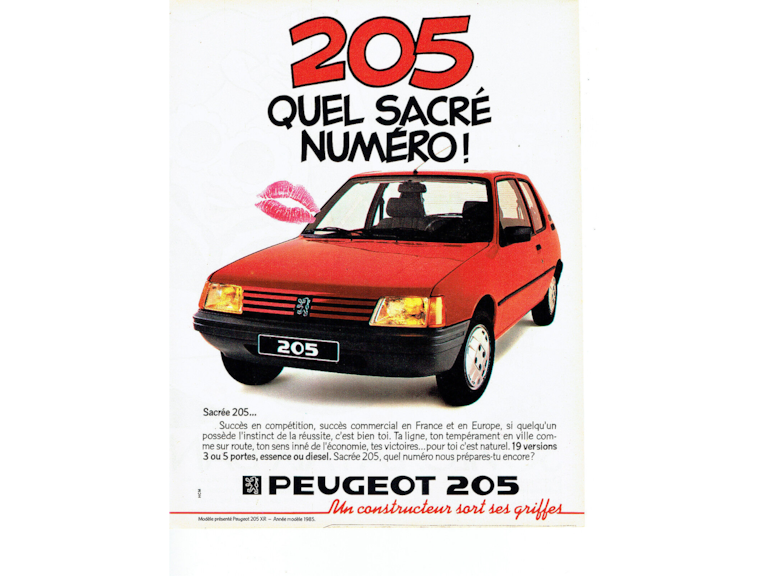21 March 2023
6 minutes read
24 February 1983: the Peugeot 205 lets out its first roar and leaves its mark on automotive history. In a long line of successful Peugeot city cars, the 205 became a symbol of modernity.
Here we look back at 40 years of impressive urban style.

Until then, most Peugeots had been designed by Pininfarina. The 205, however, was the brainchild of Gérard Welter's team of in-house stylists, who ran an internal competition to come up with the most modern and fluid design they could think of.
Gérard Welter joined Peugeot in 1960 at the age of 17 and spent his entire career there. His most spectacular success was, by his own admission, the Peugeot 205. It marked a break with the past and was a real turning point in the Marque's history.
Until then, most Peugeots had been designed by Pininfarina. The 205, however, was the brainchild of Gérard Welter's team of in-house stylists, who ran an internal competition to come up with the most modern and fluid design they could think of.
Gérard Welter joined Peugeot in 1960 at the age of 17 and spent his entire career there. His most spectacular success was, by his own admission, the Peugeot 205. It marked a break with the past and was a real turning point in the Marque's history.
Sales and channel champion
The Peugeot 205 was our first small model to receive such a wide range of engines – from 45 to 200 horsepower! It also featured an automatic gearbox, a rare option on the market at the time. From its launch in 1983, it was offered in three petrol versions. The diesel would make its appearance a few months later.
Sales and channel champion
The Peugeot 205 was our first small model to receive such a wide range of engines – from 45 to 200 horsepower! It also featured an automatic gearbox, a rare option on the market at the time. From its launch in 1983, it was offered in three petrol versions. The diesel would make its appearance a few months later.
Peugeot 205 junior
In 1984, 1985 and 1990, the 205 was the best-selling car in France. Motor sport became a powerful vehicle for promoting the Peugeot 205, and Peugeot as a brand. In 1984, under the impetus of Jean Todt, Peugeot entered the premier category of the World Rally Championship, the famous Group B, with the impressive 205 Turbo 16.
Peugeot 205 junior
In 1984, 1985 and 1990, the 205 was the best-selling car in France. Motor sport became a powerful vehicle for promoting the Peugeot 205, and Peugeot as a brand. In 1984, under the impetus of Jean Todt, Peugeot entered the premier category of the World Rally Championship, the famous Group B, with the impressive 205 Turbo 16.
In 1985, the Stellantis group presented a prototype of an electric 205. They announced it would have 87 miles of all-electric range, and a top speed of 62 mph. The interior space was the same as the petrol version's, as the powertrain and battery were housed entirely under the bonnet.
The prototype worked in a very similar way to modern electric cars. An electronic control system made it possible to suppress the gearbox. By pressing the accelerator pedal, the engine speed gradually increased, and lifting the foot from the accelerator pedal enabled the engine to brake. The electric motor then worked as a current generator, feeding its energy into the battery.


- 23 February 1983: press presentation of the Peugeot 205 Turbo 16
- 24 February 1983 : launch of the Peugeot 205 in 5-door version
- 1984 : launch of the Peugeot 205 3-door and the Peugeot 205 GTI 1.6 105 BHP, marketing of the Peugeot 205 Turbo 16, first victory in the World Rally Championship (Finland)
- 1985 : the Peugeot 205 Turbo 16 is the World Rally Champion (with Timo Salonen), the millionth Peugeot 205 leaves the Mulhouse factory
- 1986 : launch of the Peugeot 205 Cabriolet, the GTI 115 and 130 BHP, the Peugeot 205 Turbo 16 is the World Rally Champion (with Juha Kankkunen)
- 1987 : the Peugeot 205 receives a new dashboard, the Peugeot 205 Turbo 16 wins Paris-Dakar
- 1988 : launch of the Peugeot 205 Rally, second victory of the Peugeot 205 Turbo 16 in Paris-Dakar
- 1989 : launch of the Peugeot 205 Roland Garros
- 1990 : slight restyling (indicators, rear lights, etc.), launch of the Peugeot 205 Diesel Turbo (78 BHP)
- 1993 : discontinuation of the Peugeot 205 GTI
- 1995 : discontinuation of the Peugeot 205 Cabriolet
- 1998 : the Peugeot 205 is replaced by the Peugeot 206

Fans of the Peugeot 205 can order the 1:18 and 1:43 scale miniatures on the online shop:








